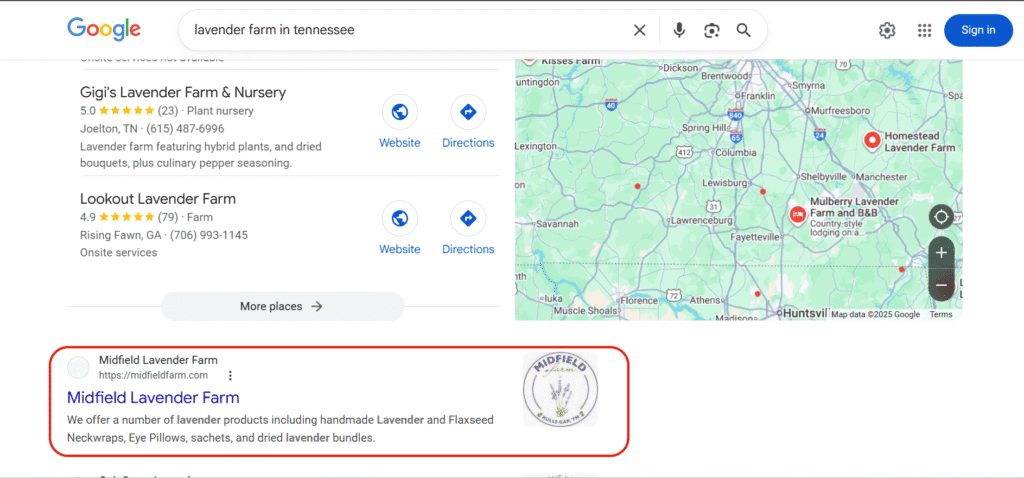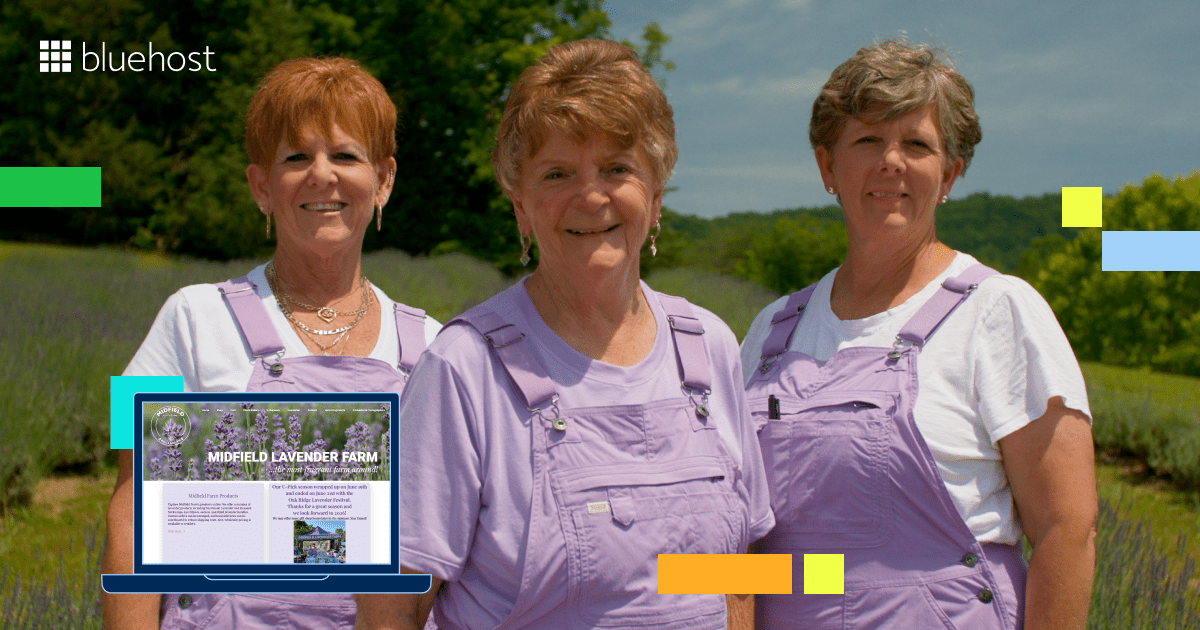What began as a small family retreat in Bulls Gap, Tennessee, has blossomed into a thriving farm eCommerce business. Today, it reaches customers far beyond the rolling lavender fields.
For the founders, Jeannie and Brian Miller, selling handmade products once meant setting up at farmers’ markets and relying on word-of-mouth in their rural community. But as the demand for fresh produce, dairy products and other agricultural products grew, so did the need for a reliable way to sell online and connect with more customers.
That’s when they turned their vision into a farm eCommerce website backed by Bluehost.
“2024 was a big step opening our farm to the public,” Jeannie recalls. “That experience really opened our eyes to the potential to grow this business and offer a unique, relaxing experience to our guests.“
Today, Midfield Lavender Farm’s online store supports everything from product sales and event bookings to community outreach. A true small business website success story that shows how the right platform can change the future for farmers and regional producers.
With our reliable WordPress hosting, the Millers built a digital home that reflects the beauty of their farm while making it easier to manage inventory, process payments and grow their customer base.
How can farmers grow from local markets to a farm eCommerce website?
For Midfield Lavender Farm, the journey from a quiet family retreat to a thriving farm business began at farmers’ markets. The Millers sold fresh produce, farm-made items, and value-added products directly to local customers, building relationships one sale at a time.
But as interest grew, so did the limitations. Rural markets could only bring in a limited number of buyers. At the same time, wholesale buyers, grocery stores and potential customers in other regions were eager for access. This reflected a wider shift: farmers and regional producers everywhere are turning to online platforms to sell online, connect with consumers and expand beyond traditional outlets.
Agritourism is also on the rise, with farms becoming both destinations and suppliers. From food hubs to selling handmade products online, small farms are finding new ways to thrive in niche markets by building digital storefronts.

For the Millers, the first step was simple: they looked closely at their sales process at markets to identify where a website could save time and streamline operations. They also tracked which agricultural products and handmade goods generated the most interest. These insights later guided what they featured on their farm eCommerce website.
As their customer base expanded, they quickly realized local sales were only the beginning.
1. Meeting customers beyond local sales
What started with selling lavender bundles to neighbors soon turned into a growing demand for seasonal goods and handmade items. The Millers saw interest from retail outlets and grocery stores. This proved proof that their farm business had the potential to scale with the right tools in place.
But with new opportunities came challenges and the lack of a dedicated farm website made it difficult to keep up.
2. Challenges of selling without a farm website
Running everything offline created hurdles. Tracking inventory across events, handling customer orders and covering shipping costs all took time away from farming. Managing inventory manually was difficult and using popular platforms came with high fees and limited control over site design.
The Millers knew they needed a user friendly, cost-effective way to sell online, one that would give them more control over their business as it grew. These challenges set the stage for the Millers to find a digital solution that could grow with them.
How to find the right platform to sell farm products online?
When Jeannie and Brian Miller realized they needed more than farmers markets to keep up with demand, they began looking for a way to build a reliable online presence for their farm. Their goal was simple. They wanted to create an online store that could showcase their products and share event details. They also wanted to make it easier for local customers and wholesale buyers to stay connected.
When it came to choosing a platform, their decision was shaped by both past experience and future needs.
Why did Midfield Lavender Farm choose Bluehost?
The Millers’ choice of Bluehost was a natural progression. Jeannie had previously built a site for her graphic design business with JustHost, a provider that later merged into Bluehost’s parent company.
When the time came to launch their farm’s digital presence, Bluehost emerged as the default choice and quickly proved to be the ideal solution. Once they selected Bluehost, the process of building their online presence began.
“Bluehost has excellent customer service. You can always talk to a knowledgeable person directly without a long wait time.” Jeannie says.
That kind of support was essential for the Millers, who admit they are not naturals when it comes to technical knowledge or web design. With Bluehost, they gained a platform that was both user-friendly and dependable. It allowed them to focus on growing lavender, creating value added products and meeting the growing demand for fresh produce and handmade goods.
Creating a WordPress site with Bluehost
In 2017, they launched their WordPress site with Bluehost. Even without advanced technical skills, they were able to build and maintain a digital presence that reflected the calm, inviting feel of their fields. Bluehost gave them more control than popular platforms that often come with high fees and limited flexibility.
For other farmers considering a farm eCommerce website, it’s worth comparing options carefully. When choosing a farm website builder, look at:
- A quick setup – To save time compared to platforms with complex needs
- Inventory tools and advanced features – To manage inventory and customer orders easier
- Start small and scale anytime – Get flexible plans that grow with your farm business needs.
- Built-in support – Free resources and quick assistance that can guide new farmers through the learning curve
For Midfield Lavender Farm, Bluehost checked every box.
“We have a lot of things to worry about and the website is not one of them.” Jeannie explains.
With their new site in place, the Millers discovered practical ways to use it for selling products and running their farm business more smoothly.
How to sell handmade and farm goods online: Midfield’s experience
Building a successful farm store website isn’t only about going digital. It’s about creating a seamless way for customers to browse, order and stay connected. Midfield Lavender Farm’s story offers practical lessons for any farm business looking to sell online. Their experience also offers broader lessons that any farmer can apply when selling products online.
1. Setting up an eCommerce store with WooCommerce
For Jeannie and Brian, Bluehost WordPress hosting provided the foundation for their farm’s online store. By integrating WooCommerce, they gained access to a wide range of tools. These tools allowed them to create a farm eCommerce website tailored to their needs. They used it for everything listing handmade wellness products to promoting seasonal U-Pick events.
With an intuitive setup, WooCommerce gave them flexibility without the complexity, helping them serve both local customers and visitors beyond their rural community.

2. Managing inventory and orders smoothly
As demand grew, keeping track of customer orders became critical. With WooCommerce’s features for inventory management and advanced product search, farmers like the Millers can streamline operations. They can sell directly to consumers. They can also stock grocery stores. Along with that, they can fulfill requests from wholesale buyers with ease.
Instead of juggling spreadsheets or manual records, a digital storefront with advanced features simplifies the entire sales process. It helps farmers save time, manage customer orders with ease and handle complex needs as their farm business grows.
Also read: What is WooCommerce? A Comprehensive Guide
3. Showcasing produce with great photography and site design
One of the biggest advantages of a farm website is the ability to highlight what makes your products special. For Midfield Lavender Farm, their online presence reflects the same calm and inviting atmosphere as their fields. Good visuals play a big role in this. High-quality product photos make value added products, dairy goods and fresh produce stand out. Thoughtful site design ensures potential customers feel confident when placing an order.
Clear descriptions also build trust, helping buyers understand what they’re purchasing, whether it’s lavender bundles, handmade soaps or bundled packs of farm goods. Offering product bundles is not only convenient for customers but also a smart way to increase profits.
How to sell farm products online successfully?
Launching a farm eCommerce website is just the beginning. To truly succeed, farmers need to build trust, streamline their sales process and use smart marketing practices that connect them with more customers. Midfield Lavender Farm’s journey shows how small steps can make a big difference.
1. Building trust with customers
Trust is the foundation of every purchase, especially in fresh produce, dairy products or value-added goods. A secure checkout system, clear product details and transparent shipping costs reassure buyers that they’re in good hands. For Midfield Lavender Farm, their Bluehost-powered farm website ensures a smooth and reliable service. It gives customers the confidence to order online, whether they’re local shoppers or wholesale buyers.
2. Use SEO to reach more customers
Optimizing your site for search engines also builds credibility. When potential customers search for fresh produce, dairy products or value-added goods and find your farm website on Google. It instantly reinforces trust. Use tools like Yoast SEO makes the process easier.
It helps you add the right keywords, optimize meta descriptions and improve readability for both users and search engines. Simple SEO practices, like using clear product titles, adding alt text to images and posting updates regularly and with the guided help from Yoast farms can reach more buyers while keeping their business visible online.
3. Processing payments and deliveries with ease
Every farm business faces challenges when processing payments and coordinating deliveries. With the right tools in place, farms can let customers pay online, simplify order fulfillment and save time managing logistics. Streamlined shipping options not only reduce errors. Food hubs and regional producers benefit too, since they are often looking for consistent suppliers.
4. Marketing through email and social media
A professional farm website doesn’t just sell, it helps you connect. Midfield Lavender Farm uses their site to share seasonal updates and events, but farms can go further with tools we provide at Bluehost. With Creative Mail for WordPress, you can design and send newsletters right from your dashboard, no third-party apps required. And with Google Workspace integration, you can send those updates from a farm-branded email (like [orders]@[yourfarm].com) to build trust and credibility with local customers.
Social platforms add another layer. Instagram and Facebook showcase fresh produce and events, Pinterest helps attract new customers and YouTube is perfect for “day on the farm” videos. To ensure those posts bring traffic back, Yoast SEO for eCommerce helps your site rank for searches, just like it helped Midfield farm to rank on 1st position for keyword “lavender farm in Tennessee“.
What farm marketing ideas really work?
For Midfield Lavender Farm, growth wasn’t just about building a farm eCommerce website. It was also about creating experiences that made customers feel connected to their farm year-round. Their marketing efforts show how the right mix of online tools and offline activities can help a farm business reach more customers, build trust and increase profits.
1. Hosting seasonal events and farm visits
The Millers used their farm website as a central hub for promoting seasonal activities like U-Pick lavender sessions, live music and guided farm visits. By selling tickets directly through their online store, they turned their site into a gateway for community access. Visitors could easily check event details, buy passes and plan their trip in advance, making the farm not just a place to shop but also a destination.
2. Collaborating with local and regional producers
Partnerships have also played a key role in expanding reach. By collaborating with other farmers, regional producers and food hubs, Midfield brought in new audiences while supporting fellow small businesses. Featuring local honey, pottery and handmade goods in their shop gave their online and retail offerings a wider appeal, while helping other makers sell online without the burden of building their own platforms.
3. Using the website as a community hub
The Millers’ WordPress site isn’t just for sales. It’s a community space where local customers can find resources, sign up for newsletters and stay informed about seasonal updates. Sharing best practices, promoting sustainability and offering tips through blog posts transformed their site into more than a storefront, it became a trusted source of connection for consumers and buyers alike.
4. 5 farm marketing ideas you can try this season
As Midfield Lavender Farm discovered, small creative ideas can make a big difference. Here are five seasonal marketing tactics worth trying.
- Launch a seasonal product bundle through your farm eCommerce website
- Offer free farm visit passes in exchange for newsletter signups
- Collaborate with a local bakery or dairy farm to create value added bundles
- Run a social media giveaway to reach more customers
- Start a farm blog to share growing tips and connect with new farmers
These efforts, paired with their website, led to measurable results that reshaped their business.
How Bluehost transformed Midfield Lavender Farm’s business?
With a reliable farm eCommerce website built on Bluehost, Midfield Lavender Farm turned local demand into measurable growth, proving how the right platform can transform a small business.
1. Sales growth and more customers
Since launching their farm website with Bluehost, Midfield Lavender Farm has seen remarkable growth. In just five years, sales increased by more than 300%, transforming a small operation that once relied on farmers markets into a thriving farm eCommerce website serving local customers, visitors and wholesale buyers across Tennessee and beyond.
“Since creating our website, our sales have grown by 300% in the last 5 years and 2025 is shaping up to be another great year.” Jeannie says.
Their online store not only supported sales of fresh produce, dairy products and value-added products but also opened doors to new opportunities. Products are now stocked in multiple grocery stores and seasonal events draw hundreds of visitors who discover the farm online first.

2. A game changer for their business
For Jeannie and Brian, having a reliable digital platform was about more than just numbers, it simplified their entire sales process. Instead of struggling with managing inventory, handling customer orders or juggling shipping costs manually, they gained tools that saved time and gave them more control over how they sell online.
The site also strengthened relationships with consumers and community members, allowing them to stay connected year-round through newsletters, event updates and social channels. What started as a side project turned into a small business website success story, showing how the right website builder can be a true game changer for farmers.
“We’ve never had a business interruption that affected our site or kept guests from placing orders or finding information.” Jeannie said
Their success proves what’s possible with the right tools and now, other farmers can follow the same path.
How to build your farm website with Bluehost?
Midfield Lavender Farm’s journey is a great example to show what’s possible when small farms embrace the right platform. Whether you’re selling fresh produce, dairy products or value-added goods, launching a farm store website is more straightforward than most new farmers expect. With Bluehost, you can move from idea to online store quickly, even without advanced technical knowledge.
Step-by-step farm website launch guide
Building a professional farm website doesn’t have to be complicated. Here’s how we help you get started:
- Choose a Bluehost plan: Every farm business is different. We offer flexible plans that work whether you’re starting small or need advanced features for wholesale buyers and larger farm eCommerce websites.
- Start with our WooCommerce Hosting: Our WooCommerce Hosting plan works like an online store bundle. It combines WordPress hosting, a free SSL certificate and essential eCommerce tools in one package. This setup reduces complexity and helps you avoid the high fees that often come with general website builders.
- Design your store with WonderSuite: First impressions matter. With WonderSuite, our AI-powered website builder, you can create a professional design that matches your farm’s brand in minutes.
- Add products and prices: Using WooCommerce, you can easily list fresh produce, lavender bundles or value-added goods. We make adding SKUs, pricing and clear descriptions simple, even for new farmers with limited technical skills.
- Enable shipping and payment options: We help you connect secure payment gateways and shipping calculators to streamline processing payments and handling shipping costs.
- Promote with email, social and SEO: With Creative Mail for WordPress, you can send newsletters right from your dashboard. Pair this with social channels like Instagram and Facebook and use Yoast SEO for eCommerce to optimize your product pages so your farm shows up when customers search for “how to sell farm products online.”
This process gives you more control than many popular platforms that come with high fees and limited flexibility and it’s all supported by our tools and expertise.
Tools and support farmers can rely on
We simplify growth by offering bundled tools, plugins and dependable support designed for farmers and small businesses:
- WonderSuite: Our AI-powered builder to guide you through setup and growth
- WooCommerce hosting (eCommerce essentials plan): Optimized for running your WooCommerce farm store smoothly.
- Yoast SEO for eCommerce: Use SEO to reach more customers and make your farm products rank
- YITH plugins: Add advanced features like product bundles, wishlists and one-click checkout
- Google Workspace + Professional Email: Build trust with a branded farm email (like [orders]@[yourfarm].com)
- 24/7 support: Our experts are always here to help you troubleshoot, design or scale
These tools save you time, reduce complexity and reflect our strong focus on helping farmers run their farm eCommerce websites confidently. Whether you’re in rural areas serving local customers or expanding to wholesale buyers and grocery stores, we at Bluehost are here to help.
We provide the tools to establish a professional presence across web and mobile, while helping you connect your farm with a broader community. But what makes Bluehost stand out compared to other platforms? Let’s take a closer look.
Why is Bluehost the right platform for farm eCommerce websites?
When farmers and small businesses look to sell online, the choices can feel overwhelming. Many turn to general website builders or third-party eCommerce platforms, but those often come with high fees, limited flexibility or feature gaps that make it hard to manage a growing farm business.
Bluehost provides an ideal solution by combining WordPress with hosting built for growth. Farmers gain more control over their farm eCommerce website, without the restrictions they might encounter on other services.
Comparison of features, costs and flexibility
For Midfield Lavender Farm, having the right mix of flexibility, affordability and support was essential. The table below highlights how Bluehost compares to other online options for farms with similar needs.
| Feature / Platform | Bluehost | General website builders / eCommerce platforms |
| Setup speed | Quick setup with WordPress + WooCommerce | May involve rigid onboarding or limited setup paths |
| Site design control | Full customization with WordPress themes and plugins | Limited templates, less flexibility for unique farm needs |
| Inventory management | Advanced tools for managing inventory and customer orders | Basic tracking, advanced features often cost extra |
| Fees | Transparent pricing, fewer ongoing high fees | Higher transaction or monthly costs can reduce profits |
| Scalability | Built to grow with your farm business and complex needs | May require costly upgrades to expand |
| Support | 24/7 customer support and knowledgebase resources | Limited support channels, self-service only in many cases |
| Marketing tools | Integrated email marketing and SEO features | Reliant on third-party add-ons |
| Community focus | Trusted by farmers, regional producers and small businesses | Designed for general audiences, not tailored to farms |
With Bluehost, businesses like Midfield Lavender Farm could create a WordPress site that feels authentic, manage products with ease and save time on the sales process.
By avoiding the high fees and limitations of other platforms, they gained a dependable way to sell online, reach more customers and connect with their community year-round. Once your site is built, the next step is making sure customers can actually find it online.
How to promote your farm website and reach more customers?
Setting up your digital storefront is step one, the next step is getting customers to it. The real work is helping customers find you, whether they’re in your own community or across the state. Here are some simple, proven ways to spread the word.
Promote your farm site by showing up where your customers already spend time, online and offline.
1. Be easy to find on Google
- Use clear product names like “fresh produce bundles” or “dairy products” in your site titles and descriptions
- Add alt text to product photos so search engines know what you’re selling
- Keep your farm website fresh with blog posts or updates (think: best practices for storing lavender or how to sell farm products online)
2. Stay in touch with email
- Add a simple sign-up form to your site, offer seasonal discounts or a free farm visit pass to encourage signups
- Send short updates on what’s in season, special bundles or upcoming events
- Build loyalty with local customers and let wholesale buyers know what’s new
3. Share your story on social
- Instagram: Post photos and reels of your fields, products and “day on the farm” moments to make customers feel connected
- Facebook Marketplace: List seasonal products and event tickets to reach nearby shoppers
- Pinterest: Share recipe ideas or DIY uses for your products, it’s a great way to reach new audiences
- YouTube: Create short videos or tutorials that highlight your farm practices, seasonal harvests or behind-the-scenes stories to engage potential customers and build trust
4. Get listed locally
- Add your farm to community directories, local food hubs and agritourism website examples
- Make sure your contact details are correct so regional producers and buyers can easily connect with you
When you combine search, email and social outreach, your farm business doesn’t just sell products; it builds a stronger community that keeps coming back for more. With the right promotion strategy in place, you’re ready to take the next step toward building your own success story.
Final thoughts: Build your own success story with Bluehost
Midfield Lavender Farm began with a simple dream, a few rows of lavender and weekends at farmers’ markets. Today, with the help of a reliable digital storefront built on Bluehost, Jeannie and Brian Miller have increased their business sales by 300%. Bluehost WooCommerce hosting helped them turn their vision into a thriving farm business that reaches more customers, supports wholesale buyers and strengthens their local community.
Their story shows what’s possible when passion meets the right platform. Midfield Lavender Farm is proof of small business growth with Bluehost. Our WooCommerce farm store example shows how even new farmers can sell products, manage orders and stay connected with customers all year long.
Grow your business beyond the farmstand by launching your eCommerce website with Bluehost today.
FAQs
The best website builder for farms is one that’s simple to use, cost-effective and built to scale. At Bluehost, we provide WordPress hosting with WonderSuite, which helps farmers quickly set up a professional farm eCommerce website. With built-in tools for inventory, payments and marketing, you get more control than popular platforms that often come with high fees.
To sell farm products online, you’ll need a farm website that works as your digital storefront. With Bluehost, you can:
1. Create a WordPress site with WordPress hosting
2. Add your fresh produce, dairy products and value-added goods
3. Enable secure checkout and manage shipping costs
4. Promote your site through email marketing, social media and SEO tools like Yoast
This makes it easy to connect with both local customers and wholesale buyers.
Yes, absolutely. Midfield Lavender Farm is a great example. After creating their farm eCommerce website with Bluehost, their sales grew by more than 300% in just five years. A website helps small farms reach more customers beyond farmers markets and rural areas, making it easier to sell products year-round.
SEO (search engine optimization) makes your farm website easier to find on Google. With Yoast SEO for eCommerce, included in our hosting plans, you can optimize product titles, images and descriptions. This helps your farm store website rank higher when people search for things like fresh produce near me or how to sell farm products online.




Write A Comment